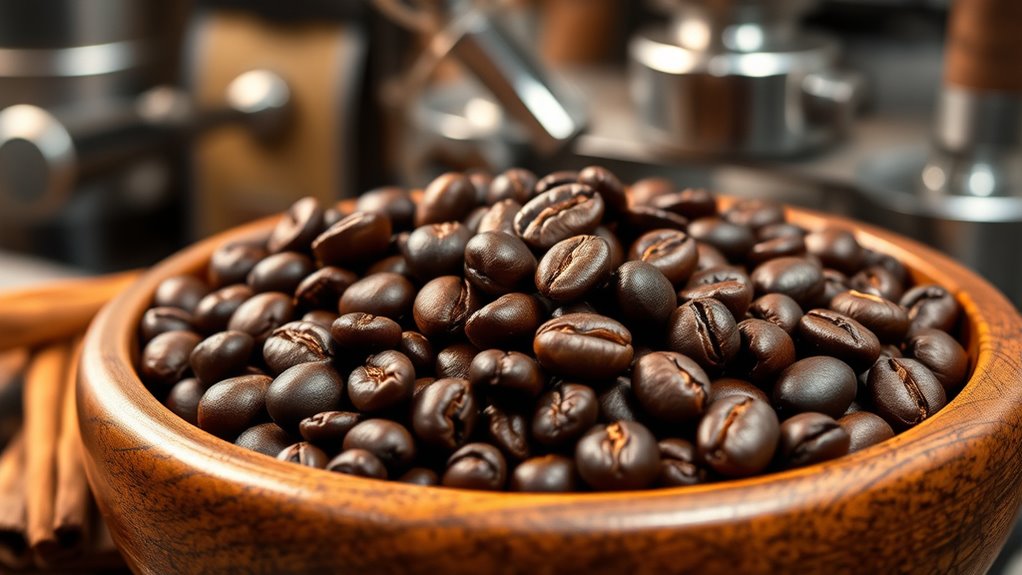Coffee roasting changes flavor profiles by transforming the beans through heat and time. In the roasting process, different stages, such as drying and the Maillard reaction, create complex flavors. Light roasts emphasize bright, fruity notes, while dark roasts develop bold, smoky characteristics. The duration and temperature of roasting also balance sweetness and acidity. Each roast level drastically alters the coffee’s taste. Explore further to uncover how each method and stage uniquely shapes your favorite brew.
Key Takeaways
- The roasting process includes drying, browning, and development phases, each impacting flavor characteristics significantly.
- Light roasts preserve original bean flavors, offering bright acidity and fruity notes, while dark roasts emphasize bold, smoky flavors.
- The Maillard Reaction during roasting creates complex flavors and enhances sweetness, crucial for developing the coffee’s overall taste profile.
- Longer roasting times deepen sweetness but risk introducing bitterness, altering the balance of flavor characteristics.
- Roast darkness influences visual appearance and flavor intensity, with increased oiliness in darker roasts affecting taste perception.
The Role of Coffee Bean Varietals in Flavor Development
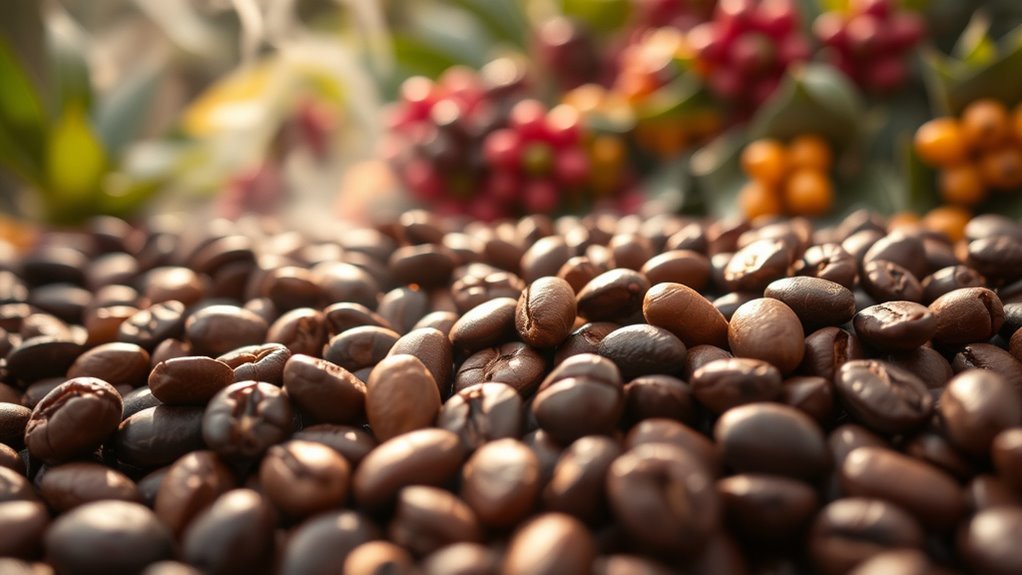
When you explore the diverse world of coffee, you’ll quickly realize that coffee bean varietals play a crucial role in shaping flavor development.
Primarily, Arabica and Robusta varietals influence the flavor characteristics you experience. Arabica often delivers sweeter, more complex flavors, while Robusta presents a bolder, bitter profile due to its higher caffeine content.
Arabica beans offer sweetness and complexity, while Robusta delivers bold bitterness with higher caffeine levels.
Each varietal’s unique terroir—affected by soil, altitude, and climate—contributes distinct flavor notes, ranging from fruity and floral to nutty and chocolaty.
In specialty coffee, strict criteria guarantee only those with desirable flavor characteristics are processed. This commitment to quality reflects the long-term investment in coffee production, as it typically takes 3-5 years from seed to cup, showcasing unique flavor profiles at harvest.
Environmental Influences on Coffee Flavor Before Roasting
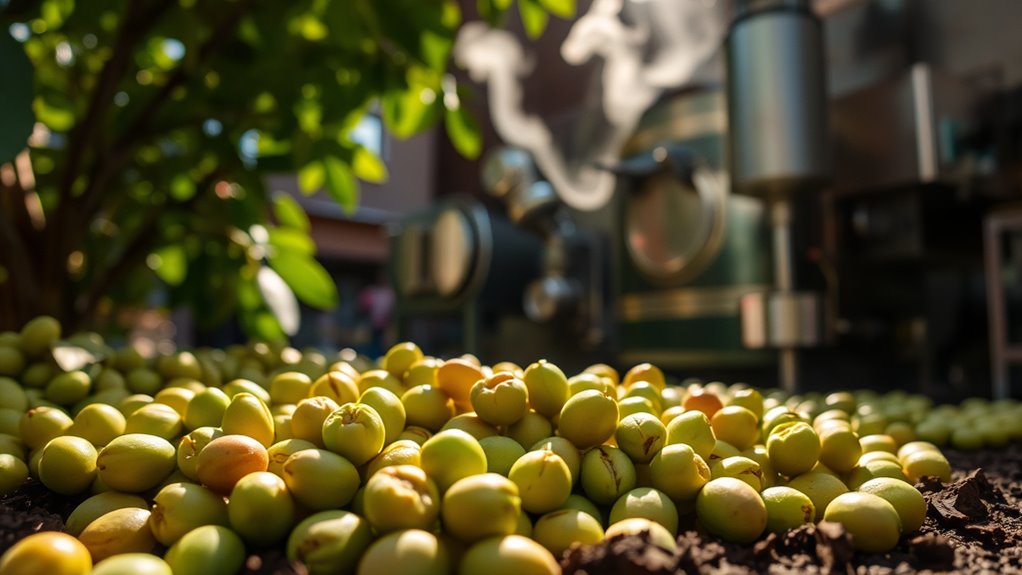
Coffee flavor development doesn’t stop with varietals; environmental factors play a vital role before the roasting process even begins.
The unique terroir of each coffee lot, shaped by soil composition, altitude, rainfall, and sun exposure, greatly influences the flavor characteristics of coffee beans. As coffee cherries ripen, they develop distinct flavor notes, which are essential for achieving the desired tasting profile.
Specialty coffee demands that cherries are harvested at peak ripeness, as under-ripe or overripe fruits can ruin origin flavors. Each varietal, especially Arabica and Robusta, showcases its own potential, and the journey from seed to cup takes 3-5 years, emphasizing how important environmental influences are in determining the final flavor before roasting.
The Impact of Processing Methods on Flavor Profiles
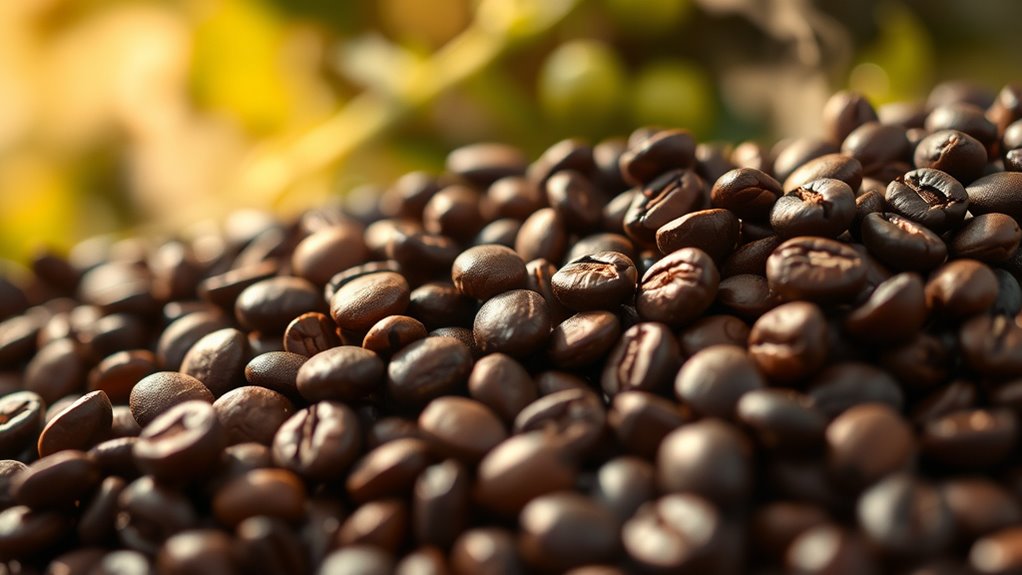
Processing methods play an essential role in shaping a coffee’s flavor profile, as they directly affect how the beans develop and express their inherent characteristics.
In specialty coffee, the ripeness of cherries and the chosen processing method are important. Natural processing enhances sweetness by drying the beans in their original cherries, while washed processing results in a cleaner and crisper taste.
Honey processing, on the other hand, retains some mucilage, giving you a unique flavor profile that blends the best of both worlds, often with lingering sweetness.
Proper storage conditions for green beans are necessary to prevent flavor degradation, ensuring that the unique characteristics developed during processing shine through in your cup of coffee.
Understanding the Roasting Process and Its Effects

When you roast coffee, you’re engaging in a complex process that unfolds in three key stages: drying, browning, and development.
Each stage plays a critical role in shaping the flavors you’ll eventually taste. Understanding how temperature and timing influence these stages helps you achieve the perfect cup.
Roasting Stages Explained
Understanding the roasting stages is essential for anyone looking to appreciate the depth of flavors in their cup.
The roasting process consists of three main stages: the drying process, the Maillard Reaction, and the development phase. During the drying phase, moisture content decreases from 8-12%, preparing the beans for the next steps.
As roasting machines heat the beans to around 160°C, the Maillard Reaction begins, creating complex flavors and browning. The first crack marks the shift to the development phase, where exothermic reactions enhance flavor profiles.
Timing is vital here, as it balances acidity, sweetness, and bitterness. Finally, the second crack indicates dark roast characteristics, shaping your coffee roast profile and the overall tasting experience.
Flavor Development Factors
The intricacies of flavor development in coffee roasting stem from the careful interplay of several factors during the roasting process.
Understanding how these elements affect flavor profiles can enhance your brewing experience. Here are three vital factors to take into account:
- Temperature: Different heat levels can highlight varying flavor notes—gentler ramps yield floral notes, while aggressive rises bring out chocolatey tones.
- Roasting Time: The length of roasting time is essential; longer durations enhance flavors but may reduce acidity and introduce bitterness if overdeveloped.
- Chemical Reactions: Key reactions, like the Maillard reaction during the browning phase, contribute greatly to the sweetness and complexity of your coffee beans.
The Significance of Roast Darkness on Flavor Characteristics
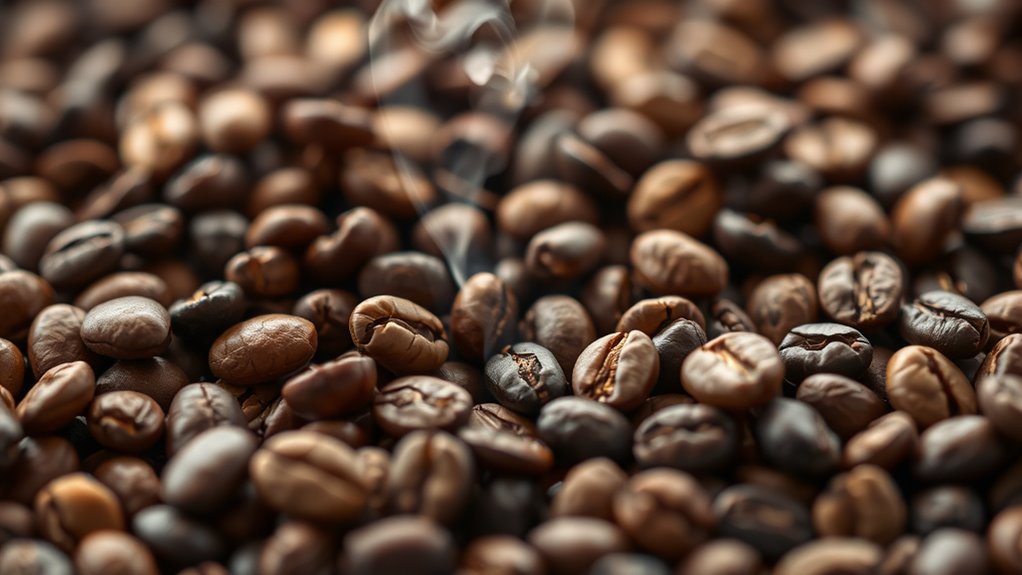
Roast darkness plays a crucial role in shaping the flavor characteristics of coffee, influencing not only what you taste but also how you perceive each cup.
Light roasts offer bright, acidic, and fruity notes, showcasing the unique qualities of the coffee beans, while dark roasts present bolder, richer flavors with a smoky undertone.
Medium roasts strike a balance, featuring flavors like caramel and chocolate that appeal to a wider range of consumer preferences.
As roast darkness increases, oils appear on the beans, affecting both visual appearance and flavor profiles.
While some enjoy the smoothness of dark roasts, others find them too bitter, revealing the subjective nature of coffee preferences and how the roasting process impacts your experience.
Advanced Techniques in Coffee Roasting and Blending

While mastering coffee roasting involves a deep understanding of various techniques, advanced methods can elevate your brewing experience considerably.
To enhance your flavor profiles, consider these advanced roasting techniques:
- Heat and Airflow Control: Adjusting these factors during roasting helps achieve consistent flavor profiles and prevents scorching.
- Timing After First Crack: Dropping your beans shortly after the first crack accentuates brightness for light roasts, while waiting brings out sweetness and complex notes.
- Blending Different Coffee Varieties: Combine beans to create unique flavor profiles that appeal to diverse palates.
The Transformation of Flavor Through Roasting Stages

When you roast coffee, you go through three key stages that shape its flavor: drying, browning, and development.
Each stage plays a vital role in transforming the beans, impacting everything from sweetness to complexity.
Understanding these phases helps you appreciate how different roast levels influence the final taste of your coffee.
Roasting Process Overview
Understanding the roasting process is essential if you want to appreciate how flavor transforms in coffee. The journey starts as coffee beans begin their metamorphosis through three key stages:
- Initial Drying Phase: Here, moisture content drops from 8-12%, setting the stage for flavor development.
- Maillard Reaction: At around 160°C, this reaction creates complex flavors and the characteristic browning of beans, critical for rich flavor profiles.
- Development Phase: This stage enhances sweetness and acidity through exothermic reactions, where timing and temperature are fundamental for achieving desired notes.
Each of these phases greatly impacts flavor, emphasizing the need for precise roast profiles to avoid drastic changes in the final outcome.
Flavor Development Phases
As the coffee beans shift through the roasting stages, each phase plays a pivotal role in shaping their final flavor profile.
The process begins with the drying phase, where moisture content decreases at around 100°C, setting the stage for transformation.
Next comes the browning phase, starting at approximately 160°C, where sugars caramelize, enhancing sweetness and creating complex flavors through the Maillard reaction.
Finally, in the development phase, occurring after the first crack, heat breaks down compounds further, introducing notes like spices, nuts, and dark fruits.
The time spent in each phase considerably influences the roast level; shorter durations preserve acidity and brightness, while longer times deepen sweetness and can introduce bitterness, ultimately defining your coffee’s flavor profiles.
Impact of Roast Level
The roast level of your coffee dramatically transforms its flavor profile, shaping how you’ll experience each cup. Understanding the impact of roast can help you choose the perfect brew.
Here are three key differences:
- Light Roasts: Retain unique bean characteristics, offering bright acidity and fruity notes.
- Medium Roasts: Strike a balance, showcasing sweetness with caramelized notes while still preserving some original flavors.
- Medium to Dark Roasts: Emphasize bold, smoky flavors with lower acidity, often leading to deeper notes like chocolate and caramel, but can also introduce bitterness if over-roasted.
During coffee roasting, the Maillard reaction plays a significant role in developing sweetness and complexity, making each roast stage essential for the final taste of coffee.
Frequently Asked Questions
How Does Roasting Affect Coffee Flavor?
Roasting affects coffee flavor by transforming the beans through heat. As you roast, the beans change color and release oils, impacting taste.
Light roasts keep their fruity notes and acidity, while dark roasts develop bolder, smoky flavors. The duration of roasting plays a vital role; shorter times maintain brightness, while longer times can introduce bitterness.
Each stage of roasting enhances complexity, allowing you to explore a range of flavors in your cup.
What Are the Flavor Profiles of Coffee Roasting?
Did you know that light roasts can have up to 30% more acidity than dark roasts?
When it comes to flavor profiles, light roasts often bring out fruity and floral notes, while medium roasts strike a balance with sweetness and complexity.
Dark roasts, on the other hand, deliver bold, smoky flavors with reduced acidity.
Each roast level offers a unique tasting experience, appealing to different preferences among coffee lovers.
What Is the 15-15-15 Coffee Rule?
The 15-15-15 Coffee Rule is all about keeping your coffee fresh.
It suggests you store your coffee in a cool, dry place, away from light, and consume it within 15 days of roasting.
After grinding, try to brew it within 15 days, and ideally, within 15 minutes of grinding for the best flavor.
Following this guideline helps preserve the aromatic compounds and guarantees you enjoy your coffee at its peak freshness.
What Does Roasting Do to Flavor?
Roasting transforms coffee’s flavor by triggering chemical reactions that develop complex aromas and tastes. As you roast beans, you’ll notice they lose moisture and weight, intensifying the flavors.
The degree of roast matters; light roasts keep fruity notes, while dark roasts lean toward bold, smoky flavors. Each crack during roasting signals changes, with the first introducing sweetness and the second revealing deeper notes like chocolate.
Proper time and temperature control are essential for achieving balanced flavors.
Conclusion
So, next time you sip that cup of joe, remember: it’s not just coffee; it’s a complex drama of bean varietals, environmental quirks, and roasting theatrics. You’re not just drinking a beverage; you’re experiencing a flavor transformation that rivals the plot twists of your favorite soap opera. Who knew choosing a roast could feel like a high-stakes decision? Just don’t blame the beans if it doesn’t taste like the artisanal masterpiece you envisioned!
